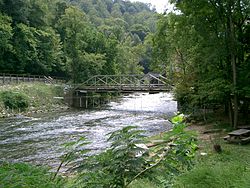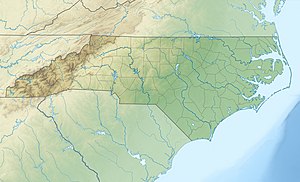| Nantahala River Tributary to Little Tennessee River | |
|---|---|
 Nantahala Bridge, showing the high water level even in late summer (September). | |
| Location | |
| Country | United States |
| State | North Carolina |
| County | Clay Macon Swain |
| Physical characteristics | |
| Source | confluence of Kilby Creek, Gulf Fork, and Big Laurel Branch |
| • location | just west of Scream Ridge |
| • coordinates | 35°01′04″N 083°30′24″W / 35.01778°N 83.50667°W[1] |
| • elevation | 3,800 ft (1,200 m)[2] |
| Mouth | Little Tennessee River |
• location | Fontana Lake |
• coordinates | 35°23′00″N 083°30′24″W / 35.38333°N 83.50667°W[1] |
• elevation | 1,708 ft (521 m)[2] |
| Length | 47.85 mi (77.01 km)[3] |
| Basin size | 175.33 square miles (454.1 km2)[4] |
| Discharge | |
| • location | Little Tennessee River (Fontana Lake) |
| • average | 612.33 cu ft/s (17.339 m3/s) at mouth with Little Tennessee River[4] |
| Basin features | |
| Progression | generally north |
| River system | Little Tennessee River |
| Tributaries | |
| • left | Indian Creek, Nichols Branch, Little Indian Creek, Kimsey Creek, Park Creek, Black Creek, Nova Scotia Branch, Buck Creek, Tate Branch, Tipton Branch, Clear Creek, Johnson Branch, Choga Creek, Lambert Cove, Dicks Creek, Appletree Branch, Walnut Cove, Poplar Cove, Pierce Creek, Rowlin Creek, Ledbetter Creek, Mudcut Branch, Mountain Branch, Morris Branch, Tomahawk Branch, Watia Creek, Jake Branch, Pump Branch, Turkey Branch |
| • right | Mooney Creek, Bearpen Creek, Thomas Branch, Hurricane Creek, Curtis Creek, Long Branch, Laurel Branch, Little Rock Branch, Trough Branch, Morris Branch, Bryson Branch, Factory Branch, Roaring Fork, Tyler Branch, Jarrett Creek, Rocky Branch, Wine Spring Creek, Rowland Branch, Beech Cove Branch, White Oak Creek, Camp Branch, Queens Creek, Silvermine Creek, Wesser Creek, Bird Falls Branch, Buckner Branch, Euchiella Branch, Siles Branch |
| Waterbodies | Nantahala Lake, Fontana Lake |
| Bridges | Standing Indian Loop, US 64, Thunderstruck Lane, Swinging Bridge Lane, Nantahala Dam Road, Junaluska Road, Wayah Road (x8), US 74, Pardon Bridge Road, Old Storehouse Road, NC 28 |


The Nantahala River (/ˌnæntəˈheɪlə/)[5] is a river in western North Carolina in the United States, within the Nantahala National Forest, and near the Great Smoky Mountains National Park. Two-lane U.S. Highway 19/74 runs along the river, picnic areas dotting the route. In 1839, this was an unimproved large path, part of what became known as the Trail of Tears as the Cherokee people were forcibly removed from their homelands in this region to west of the Mississippi River and Indian Territory.
The river rises near the border of Georgia and North Carolina, close to the Southern Nantahala Wilderness and the Appalachian Trail. It flows into the Little Tennessee River at Fontana Lake, a reservoir formed behind Fontana Dam.
The word Nantahala is Cherokee and means "Land of the Noonday Sun".[6] The river runs through a narrow and steep gorge where in some areas the sun reaches the ground only when it is directly overhead during the middle of the day. During the colonial era, Cherokee towns along the Nantahala, upper Hiwassee River, and Valley River in what is now North Carolina were known as the Valley Towns.
- ^ a b "GNIS Detail - Nantahala River". geonames.usgs.gov. US Geological Survey. Retrieved 17 October 2019.
- ^ a b "Nantahala River Topo Map, Swain County NC (Noland Creek Area)". TopoZone. Locality, LLC. Retrieved 17 October 2019.
- ^ "ArcGIS Web Application". epa.maps.arcgis.com. US EPA. Retrieved 17 October 2019.
- ^ a b "Nantahala River Watershed Report". Waters Geoviewer. US EPA. Retrieved 17 October 2019.
- ^ Talk Like A Tarheel Archived 2013-06-22 at the Wayback Machine, from the North Carolina Collection's website at the University of North Carolina at Chapel Hill. Retrieved 2013-02-05.
- ^ Mohlenbrock, Robert H. (14 May 2014). This Land. University of California Press. p. 223. ISBN 978-0-520-93055-1.


